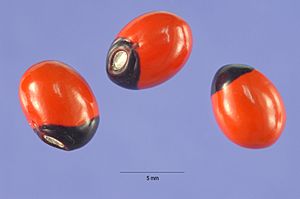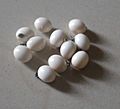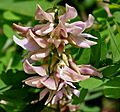Jequirity bean facts for kids
Quick facts for kids Jequirity bean |
|
|---|---|
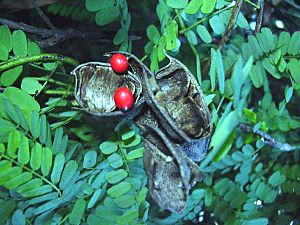 |
|
| Scientific classification | |
| Genus: |
Abrus
|
| Species: |
precatorius
|
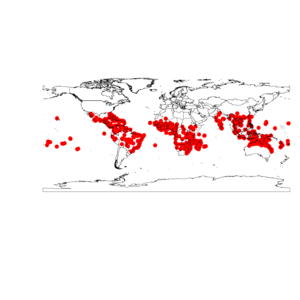 |
|
| Occurrence data from GBIF | |
| Synonyms | |
|
|
The Abrus precatorius, often called jequirity bean or rosary pea, is a type of flowering plant in the bean family, Fabaceae. It's a thin, climbing plant that lives for many years. Its long leaves have many small leaflets, and it wraps itself around trees, bushes, and hedges.
This plant is most famous for its seeds. People use these seeds as beads for jewelry and in musical instruments. However, the seeds are very toxic because they contain a substance called abrin. Eating even one well-chewed seed can be deadly for both children and adults. The plant originally comes from Asia and Australia. It can easily spread and become a weed in new places where it is introduced.
Contents
Common Names of the Rosary Pea
Abrus precatorius has many common names around the world. Some of these include jequirity, Crab's eye, rosary pea, paternoster pea, love pea, precatory pea or bean, prayer bead, John Crow Bead, coral bead, and red-bead vine. It's also known as country licorice, Indian licorice, wild licorice, and Jamaica wild licorice. In some places, it's called Akar Saga, coondrimany, gidee gidee, Jumbie bead, ratti/rettee/retty, or weather plant.
How the Rosary Pea Spreads and Invades
The Abrus precatorius is a very invasive plant in warm, tropical areas. This means it spreads quickly and takes over new places. It has been introduced by humans to many parts of the world, and its bright, hard-shelled seeds are easily carried by birds. By the late 1900s, it was declared an invasive weed in many regions. These areas include parts of Belize, the Caribbean Islands, Hawaii, Polynesia, and even parts of the mainland United States. In Florida, for example, it has invaded natural areas like pinelands and hammocks.
Once Abrus precatorius plants grow big in good conditions, their deep roots are very hard to remove. The plants grow aggressively, have tough seeds, and can sprout new plants from their roots. This makes it extremely difficult to get rid of an infestation and stop it from coming back. Special plant killers called glyphosate can work, but they need to be used carefully to avoid harming other plants.
The Dangerous Toxin: Abrin
The toxin in the rosary pea is called abrin. Abrin is a protein made of two parts, called A and B. The B part helps abrin get inside a cell. Once inside, the A part stops the cell from making new proteins. This is very harmful because cells need proteins to live and work. Just one molecule of abrin can stop up to 1,500 protein-making machines (ribosomes) every second!
The symptoms of abrin poisoning are similar to those from another toxin called ricin. However, abrin is much more dangerous. It is about 75 times more toxic than ricin. Even a tiny amount, like 0.1 milligrams for an average adult, can be deadly. If someone swallows whole seeds, they might not get sick because the hard shell can prevent the toxin from being absorbed. The seeds might just pass through their body undigested.
This plant is also poisonous to horses. If poisoned, symptoms can include feeling sick, throwing up, seizures, liver failure, and eventually death, usually after several days.
Uses of the Rosary Pea
The seeds of Abrus precatorius have been used for different purposes, especially in jewelry and as a unit of measurement.
Making Jewelry and Crafts
The seeds of Abrus precatorius are highly valued for their bright colors in traditional jewelry. Most seeds are a striking black and red, looking a bit like a ladybug. However, you can also find them in other colors. Making jewelry with these seeds can be risky. There are stories that people who pierce the seeds to thread them can get poisoned from a tiny prick. However, there isn't much scientific proof to support these claims.
In Trinidad in the West Indies, the colorful seeds are strung into bracelets. People wear these bracelets around their wrists or ankles. They believe the bracelets help protect them from evil spirits and the "evil eye." In Tamil culture, people use Abrus seeds of different colors. The red variety with a black spot is the most common, but there are also black, white, and green types.
In March 2012, some bracelets made with Jequirity Beans were recalled in the UK. These bracelets were sold by places like the Eden Project.
Using Seeds as a Unit of Measure
The seeds of Abrus precatorius are very consistent in weight. This is true even when the amount of moisture in the air changes, thanks to their hard, water-resistant outer shell. Because of this, people in India historically used these seeds to weigh gold. They had a unit of measure called a Ratti. For example, 8 Ratti equaled 1 Masha, and 12 Masha equaled 1 Tola, which is about 11.6 grams.
Traditional Medicine Uses
Abrus precatorius is known by different names in various parts of India, such as "Gulaganji" in Kannada, kundu mani in Tamil, Guruvinda ginja in Telugu, and 'Kunni kuru' in Malayalam. It has been used in Siddha medicine, a traditional healing system, for hundreds of years.
Cultural Importance
In Rajasthan, India, a folk song called Chirmi song is connected to this plant. The plant also has economic value for the traditional Zulu people. They make and sell crafts using the seeds of this plant, which provides them with income.
Images for kids
See also
 In Spanish: Regaliz americano para niños
In Spanish: Regaliz americano para niños


